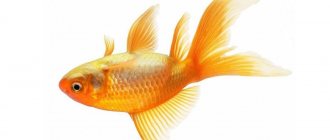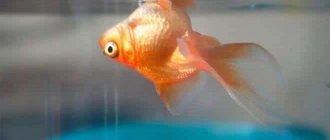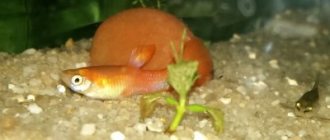Why does a goldfish swim with its belly up: reasons
An unpleasant situation happens: the owner of an aquarium approaches his home pond and sees that the fish is swimming with its belly up, but it is alive and breathing.
Before taking any action, you should try to find out the reason for this behavior. In some cases, the problem can be eliminated without the use of medications.
Basically, the reasons for this phenomenon are problems with the swim bladder.
- Firstly, it may be due to overeating. Most often this happens with veiltails and related fish. They are quite gluttonous, so they are prone to obesity. In this case, the enlarged liver squeezes the swim bladder, and the fish turns upside down.
- Another reason is feeding dry food, which does not have time to soak in water. Sometimes feeding dry food also leads to compression of the swim bladder, as the food becomes saturated with liquid and swells inside the fish.
In addition, when fish grab food from the surface of the water, they swallow air. This happens not only with veiltails, but also with neon fish, barbs, guppies, mollies and others.
The next reason is uncomfortable conditions in the aquarium. For example, lack of oxygen due to the large number of inhabitants. In this case, they crowd around the aerator.
A problem pet may feel uncomfortable due to stress caused by aggression from other residents.
A more complex cause is a foreign body stuck in the throat, for example, a small pebble from the soil.
Injuries received during fish fights or falling from an aquarium can also cause a similar phenomenon.
Finally, various diseases can cause a lack of coordination: the fish swims upside down, downside down, on its side.
The causes of diseases can be bacteria, viruses, fungi, parasites, tumors.
Swim Bladder Diseases
The main symptom is impaired coordination of movements and buoyancy.
A sick individual takes an unnatural position with its belly up, either on its side, or vertically with its tail up
Sometimes she lies at the bottom, tries to float up, but cannot.
Sometimes it swims near the surface, turning over on its back. This may cause curvature of the body and enlargement of the abdomen.
Swim bladder diseases can be caused by injury, infection, parasites, or birth defects.
Foreign bodies
Some breeds of fish like to poke around in the ground. For example, veiltails and catfish obtain food in this way. In this case, a small particle of soil may fall into the throat, which the fish will swallow.
If a foreign object gets stuck in the throat, the fish will swim with its head below its tail. Sometimes you can remove it yourself with tweezers.
If this does not work, then you need to seek help from a specialist. If the fish swims belly up or on its side, then a foreign body may be stuck in the intestine.
About symptoms
If you are concerned about the question of why guppies swim on the surface of the aquarium, first of all, observe exactly how this happens. If the fish occasionally rise to the surface and stay there, but they have a good appetite and playful behavior, then this should not bother you. Guppies live in the middle layers of water, sometimes a little higher, sometimes a little lower, and these are variations of the norm! But be careful, because the following behaviors indicate that the guppies need your help:
- The fish greedily swallows air from the surface;
- The pet has a disturbed appetite;
- Guppy swims vertically;
- The color has faded;
- Gupeshki do not sink lower, spending all their time near the surface;
The fish swims belly up: what to do?
First of all, you need to examine the problem individual and pay attention to whether it has sores, rashes, or white spots on its body.
These signs indicate infection by viruses, fungi, and parasites. Such a fish needs to be removed so that the rest of the aquarium inhabitants do not become infected. The next step is fasting for 3 days. After fasting, she should be given peeled and mashed boiled peas to eat. You can take frozen peas and boil for a minute.
Peas are given for 2-3 days, one pea per day. Peas help cleanse the intestines. If the fish is swimming upside down or on its side, and it is difficult for it to take food due to its position in the water, then you need to help by bringing the food closer to the mouth.
During a fasting diet, the water temperature should be quite warm: 26-28 degrees. Then it will be easier for the fish to float up. To do this, you can also reduce the water level.
If you suspect a swim bladder injury, you will have to wait until the injury heals on its own. At this time, the wounded fish must be created comfortable conditions and protected from its relatives.
If these measures do not help, then drug treatment is needed. In case of infection, an antibiotic is used, for example kanamycin or chloramphenicol.
If it is a fungal disease, then it is treated with methylene blue.
You need to show the sick animal to a veterinarian or consult by phone.
Escape behavior of aquarium fish
What to do if the fish is hiding
If a fish is hiding, this is a completely normal way of self-preservation for it.
- Some fish hide to lie in wait for prey. Therefore, it is quite natural that such fish will spend some part of their time in caves among plants or in other favorite secluded places.
- Some fish, especially representatives of species that care for their offspring, begin to hide during the spawning period.
- There are fish that hide at night. Nocturnal fish, on the contrary, usually sink to the bottom during the day.
- New fish recently introduced into an aquarium will often hide until they have assessed their surroundings and feel confident enough to swim out into the open.
If a fish that has not previously had the habit of hiding suddenly begins to do so, and this cannot be explained by specific behavior during spawning, then this fish is most likely unhealthy!
What to do if a fish jumps out of the water
For representatives of some species of fish, this is a characteristic behavior during escape, especially in those that constantly live near the surface of the water. In nature, they usually escape from predators in this way, but in an aquarium, such behavior is sometimes a reaction to aggression from neighbors. Some fish jump out to get food, and Arnold's Copeins jump out of the water to lay their eggs.
Some small fish that live near the surface of the water, such as representatives of the wedge-bellied or carp-toothed families, have an uncanny habit of finding even the smallest holes in the lid of the aquarium and ending their days as dull, dehydrated corpses on the floor. If you have such fish in your aquarium, or any others that are known to jump out of the water, then all possible escape routes should be carefully blocked. To prevent fish from jumping out of the aquarium, you can also use floating plants. The aquarist should set himself the goal of creating an environment for the fish such that they do not have the desire to jump at all in an attempt to avoid real or imagined danger.
Jumping can also be a reaction to poisoning or certain diseases. So if any of your fish are jumping regularly, or if a fish suddenly starts jumping that hasn't done so before, it's a cause for concern. Fish sometimes tend to leave their habitat if its parameters differ significantly from those to which they are accustomed: water temperature, pH and other parameters.
The fish can jump out of the water when threatened with a net. Since the lid of the aquarium is removed when catching fish, there is a danger that the fish may jump out of the aquarium altogether. Sick fish rarely have the strength to do this, but before catching healthy fish with a net, it is better to take a reasonable precaution - lower the water level in the aquarium. An additional partial water change will not do any harm in any case!
What to do if a fish gets out of the aquarium
Some fish, especially Clarias from the Clariidae family, as well as representatives of the Labyrinth (Anabantidae) and Snakehead (Channidae) families, are able to breathe atmospheric air and cross land areas to find another body of water if their native pond is dry. Although it is unlikely that the aquarium will ever dry out, its size and volume are certainly less than the critical minimum pond size at which these fish begin migrating in the wild. Whatever the reason, these fish may well decide to go exploring around the house if precautions are not taken. Large individuals can even move a light metal or plastic aquarium lid. Therefore, there should be no gaps between the lid and the aquarium, as well as in the lid itself, through which fish could escape. In addition, the lid must be heavy and securely fastened.
What to do if a fish buries itself in the ground
In this way, the fish simply hides - this is one of the possible forms of shelter. This is exactly how some loaches regularly hide. Keeping them in an aquarium without soil is an unacceptable solution. After all, depriving them of their natural shelter means acting unmercifully towards them, this can cause them nervousness and severe stress. Instead, they should be allowed to behave naturally, as in nature, and provide them with soil consisting of small particles without sharp edges.
What to do if the fish swims in a group
Some fish in natural conditions swim in schools for the purpose of self-defense. It is believed that the movement of a school of fish should confuse predators, and each individual fish swimming in a school has a lower statistical chance of becoming prey to a predator than if it were swimming on its own. There is an assumption that the formation of a school also plays an important role in the nutrition of such fish species. Representatives of those species of fish that usually swim in schools in nature should be kept in groups in the aquarium to prevent nervousness and stress.
There are fish that form schools not for self-defense, but because it is more convenient for them to feed, and sometimes fish of not one species, but several, gather in such schools - for example, for the purpose of exploiting an unusually rich source of food. Some fish form groups during spawning, even if they normally swim alone.
Source: “The Aquarist's Golden Book” by M. Bailey, P. Burgress
Fish diseases
When you don’t want to blame yourself for the illness of aquatic inhabitants, the blame is transferred to illness. However, you should not rush to find a panacea for fish diseases - you need to study all the probable causes of their death.
It is necessary to blame diseases only when symptoms were already present. The fish gradually fades away, and does not die at once, without any special reason. Most often, diseases are brought into the reservoir along with new plants and inhabitants. Death can occur due to a malfunction of the heating element during the cold period.
Before going to the pet store, you need to be aware of what kind of medicine is needed. Each drug is aimed at a specific disease. There are no cures for all diseases. Therefore, if possible, take advice from experienced aquarists.
Of course, the disease is not capable of killing a healthy inhabitant. Why do fish die in a tank? If the inhabitant died, it means his immune system was undermined.
Fish diseases
What to do to protect your aquarium
:
- quarantine new residents;
- check the sanitization of plantings and residents.
What to do when a disease appears in the aquarium:
- replace a tenth of the water every day;
- increase the temperature;
- increase aeration;
- exclude carriers of diseases, as well as those who are already infected.
It is extremely important to remember which inhabitant you launched the fish last. It should be understood that fish from other countries can be carriers of rare diseases, which sometimes cannot be identified independently.
Flaw 02
This option is the rarest. If the fish's home is saturated with oxygen, even a novice aquarist will appreciate it. The first thing you need to do is buy a compressor. With a compressor, suffocation of the fish is simply impossible.
One likely option is to increase the temperature, which will reduce the oxygen in the water space. This can happen at night when the plantings rearrange themselves to produce oxygen for absorption. To avoid this, do not turn off the compressor at night.
Compressor in an aquarium
Ancistrus, or Cleaner Catfish
Gennady:
12/03/2015 at 11:42
At one time, I worked with ancitrus for many years. I will share my observations. The soil was black and red marble chips; accordingly, the water hardness was higher than normal. Of the plants - Anubias, it is hard-leaved, catfish do not touch it. In the spring, I collected the first dandelion leaf without a central core, boiled it and packaged it in small nylon bottles and in the freezer. 2-3 bottles were enough for me throughout the winter, until the next leaf. In winter, I cut off the top part of the nylon from the bottle with a knife, kept it at room temperature for some time, then cut the amount I needed into thin slices and fed it. I bred it in a separate small aquarium standing right next to the window. I made all the walls of the aquarium, except the front one, from a mirror - in the light it very quickly becomes overgrown with greenery, which is a mandatory starting food for juveniles, plus aeration and filtration, of course with replacement. The yield of juveniles is one hundred percent. In order to save money and improve the feed, I bought a beef heart in a store or market, soaked it from the blood, very carefully cleaned it of fat, divided it into parts, wrapped it in cellophane and put it in the freezer. Before feeding in the evening, I grated it to create the shape of a small bloodworm. For the nest I used, who remembers, ceramic boots, ashtrays placed on their sides. The eggs are laid in the very sock, only the tip of the tail sticks out, and with its body it blocks the entrance from uninvited guests. Tried pots, tubes and finally gave up. The driftwood was taken from lakes from trees whose roots hang into the water, old, not coniferous. Very good driftwood from the bottom of drained lakes, catfish ate them completely. The driftwood should be like rotten wood, soft. The process of their preparation is described in all books and is not difficult. Anyone who can get shards from old stove tiles, be sure to place them in an aquarium, the fact is that they were poorly fired, except for the front part covered in glaze. Accordingly, the clay base itself is half-baked, but is not washed away by water. The catfish eat it with great pleasure, you can even see this by the color of the droppings. I inquired about this issue - in habitats during floods in the spring, precisely at the time of reproduction, the river is muddy with the current and there is a large amount of clay in the water, which probably affects the formation of digestion and growth at an early age, and maybe throughout life catfish There were no cases of illness. Catfish always frolicked and played catch. Good luck.
Answer
Lack of oxygen
As you know, fish breathe air dissolved in water. If there is not enough oxygen in the water, then the inhabitants may simply suffocate. Despite the fact that these cases are very rare, they do occur.
Even beginners buy in advance everything they need to ensure that their aquarium equipment works effectively. It is extremely common to purchase a powerful filter; it is trusted not only for cleaning the water space, but also for aeration and mixing. Experts strongly advise separating these two functions, as well as ensuring regular operation of the air compressor.
Water temperature
The death of aquarium fish can also be a consequence of a decrease or increase in water temperature. There is an opinion that if you deviate from the temperature by 2-3 o C, this will not affect the well-being of underwater inhabitants. However, this opinion is wrong.
If you lower the temperature, there is a likely risk of catching a cold and death, and if it rises, the inhabitant can die from insufficient oxygen.
Water temperature











